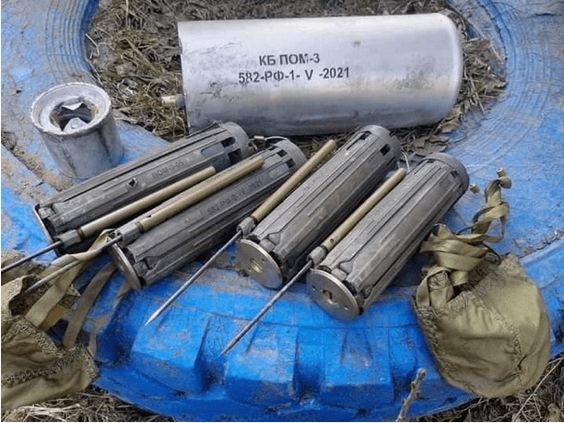
Landmines Threaten Civilian Lives, Prolong Recovery
(Berlin, March 29, 2022) – Russian forces fighting in Ukraine have used banned antipersonnel mines in the eastern Kharkiv region, Human Rights Watch said today.
The antipersonnel mines were located by Ukrainian explosive ordnance disposal technicians on March 28, 2022. Russia is known to possess these newly deployed landmines, which can indiscriminately kill and maim people within an apparent 16-meter range. Ukraine does not possess this type of landmine or its delivery system.
“Countries around the world should forcefully condemn Russia’s use of banned antipersonnel landmines in Ukraine,” said Steve Goose, the arms director of Human Rights Watch. “These weapons do not differentiate between combatants and civilians and leave a deadly legacy for years to come.”
The 1997 international Mine Ban Treaty comprehensively bans the use, production, stockpiling, and transfer of antipersonnel mines. Russia [together with China and USA] is not among the 164 countries that have joined the treaty.
This new use of antipersonnel mines marks a rare circumstance, though, in which a country not a party to the 1997 Mine Ban Treaty uses the weapon on the territory of a party to the treaty. Ukraine signed the ban treaty on February 24, 1999, and became a state party on June 1, 2006.
The mine used by Russia is a newly developed type called POM-3, also known as “Medallion,” that is equipped with a seismic sensor to detect an approaching person and eject an explosive charge into the air. The subsequent detonation of the charge and metal fragments it projects can cause death and injury within a 16-meter radius, according to the limited information available publicly on this landmine.
The POM-3 is reportedly equipped with a self-destruct device that destroys the mine after a certain amount of time, such as hours or days after deployment.
The mines were apparently delivered by rockets fired from specially designed ground launchers that were recorded on video on an unknown date and posted to social media on March 26. The markings on a delivery canister remnant pictured with POM-3 mines that failed to deploy properly indicate it was produced in 2021.
The dedicated ISDM Zemledelie-I mine-laying rocket launcher, which delivers the POM-3 mines from 5 to 15 kilometers away, first appeared during the annual Russian military exercises in 2021, according to the Landmine Monitor 2021 report. Anti-vehicle mines can also be deployed by the ISDM launcher. The POM-3 can also be scattered at short range by other types of truck-mounted launchers.
In November 2020, Russia told the United Nations General Assembly that it “shares the goals of the treaty and supports a world free of mines,” but views antipersonnel mines “as an effective way of ensuring the security of Russia’s borders.”
Human Rights Watch has documented the use of Soviet/Russian-origin antipersonnel mines in more than 30 countries, including in Syria (2011-2019), Ukraine (2014-2015), and Libya (2020), often coinciding with Russian military presence as a party in those conflicts.
“Russia’s use of antipersonnel mines in Ukraine deliberately flouts the international norm against the use of these horrid weapons,” Goose said.




23 Comments
Pingback: Russian losses in Ukraina "special military operation" - Bergensia
Pingback: onlinegames
Pingback: Side hustle
Pingback: ปั่นสล็อต
Pingback: Salbutamol Buy Online UK
Pingback: Loring Ward
Pingback: Codeless automation framework
Pingback: สลากดิจิทัล
Pingback: alpha88 เข้า ไม่ได้
Pingback: โซล่าเซลล์
Pingback: magic mushrooms where to buy
Pingback: study music
Pingback: เสือมังกร lsm99
Pingback: piano music for good sleep
Pingback: superkaya88
Pingback: bonanza178
Pingback: จดทะเบียน อย
Pingback: รับเพ้นท์ผนัง
Pingback: auto swiper
Pingback: ร้านตัดแว่นใกล้ฉัน
Pingback: download
Pingback: coinbet88 คืออะไร?
Pingback: ฟิล์มกรองแสง